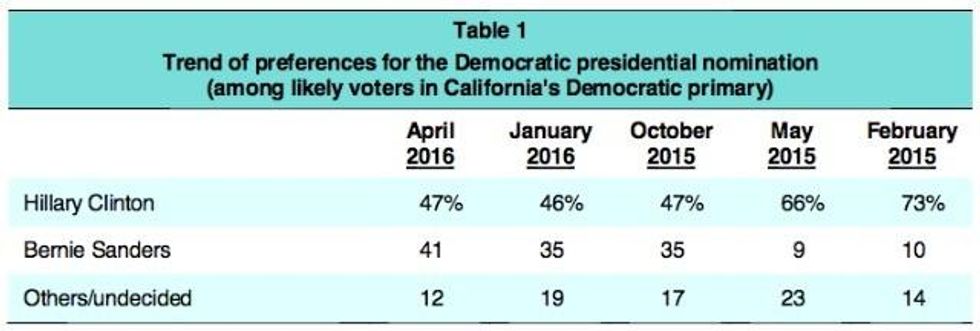

SUBSCRIBE TO OUR FREE NEWSLETTER
Daily news & progressive opinion—funded by the people, not the corporations—delivered straight to your inbox.
5
#000000
#FFFFFF
To donate by check, phone, or other method, see our More Ways to Give page.


Daily news & progressive opinion—funded by the people, not the corporations—delivered straight to your inbox.

Previous polls had Sanders trailing Clinton by significant margins in both states, and new data reflects the nationwide momentum of the Vermont senator's campaign. (Photo: Disney | ABC Television Group/flickr/cc)
As presidential hopeful Bernie Sanders' Wednesday rally in Philadelphia drew a crowd so large the line stretched ten blocks, Quinnipiac released a poll showing Sanders making double-digit gains on Hillary Clinton's once-formidable lead in the state--narrowing it to just a six-point margin.
The Pennsylvania poll showed Sanders behind Clinton among likely Democratic voters 44 percent to 50 percent in the closed-primary state; previous polling had Clinton ahead by a full 17 points. The margin of error was 4.3 percentage points.
Echoing previous polling that shows Sanders' strength as a general election candidate, Quinnipiac's poll also found Clinton tying with Cruz in a general election match-up, while Sanders beat both Trump and Cruz handily.
And in California, which offers the significant prize of 475 delegates to the nominating convention, a poll (pdf) released Friday also showed Sanders slimming Clinton's lead to only six points.
In California, the recent survey "was brimming with red flags for Clinton, who has lost six of the last seven Democratic primary and caucus contests and has raised less money than Sanders the past three months. While Clinton has a large lead in the number of delegates needed to secure the Democratic nomination, Sanders has enough money to continue running a robust campaign through the California primary," writesSFGate.
California holds its primary on June 7, while Pennsylvanians head to the polls on April 26.
The California poll, conducted by the Field Research Corporation, shows Sanders behind Clinton 41 percent to 47 percent--about half the margin of Clinton's previous lead recorded in January.

Moreover, the poll shows that in the delegate-heavy state, "Sanders is supported by a greater than four-to-one margin among voters age 18-29." Sanders also leads among renters, while Clinton is supported by a majority of homeowners, those making more than $100,000 per year, and voters over 65. The poll shows the candidates running "about even" among moderate and low-income voters.
California is a semi-open primary, meaning voters belonging to neither major party can vote in the Democratic primary. Among non-partisan voters, the poll found that Sanders leads Clinton by a full ten points.
The poll authors observe that these demographic variations "mean that relatively modest changes in the relative sizes of these voting blocs would have a big impact on each candidate's overall standing statewide."
Echoing Sanders' own argument that a high voter turnout favors his chances to win, the Field poll concludes from its findings that "turnout will play a critical role in the primary."
The speed with which Sanders has gained on Clinton in polls in the two states also reflects the nationwide momentum Sanders' campaign has gathered since his Wisconsin win beat expectations last week.
Trump and Musk are on an unconstitutional rampage, aiming for virtually every corner of the federal government. These two right-wing billionaires are targeting nurses, scientists, teachers, daycare providers, judges, veterans, air traffic controllers, and nuclear safety inspectors. No one is safe. The food stamps program, Social Security, Medicare, and Medicaid are next. It’s an unprecedented disaster and a five-alarm fire, but there will be a reckoning. The people did not vote for this. The American people do not want this dystopian hellscape that hides behind claims of “efficiency.” Still, in reality, it is all a giveaway to corporate interests and the libertarian dreams of far-right oligarchs like Musk. Common Dreams is playing a vital role by reporting day and night on this orgy of corruption and greed, as well as what everyday people can do to organize and fight back. As a people-powered nonprofit news outlet, we cover issues the corporate media never will, but we can only continue with our readers’ support. |
As presidential hopeful Bernie Sanders' Wednesday rally in Philadelphia drew a crowd so large the line stretched ten blocks, Quinnipiac released a poll showing Sanders making double-digit gains on Hillary Clinton's once-formidable lead in the state--narrowing it to just a six-point margin.
The Pennsylvania poll showed Sanders behind Clinton among likely Democratic voters 44 percent to 50 percent in the closed-primary state; previous polling had Clinton ahead by a full 17 points. The margin of error was 4.3 percentage points.
Echoing previous polling that shows Sanders' strength as a general election candidate, Quinnipiac's poll also found Clinton tying with Cruz in a general election match-up, while Sanders beat both Trump and Cruz handily.
And in California, which offers the significant prize of 475 delegates to the nominating convention, a poll (pdf) released Friday also showed Sanders slimming Clinton's lead to only six points.
In California, the recent survey "was brimming with red flags for Clinton, who has lost six of the last seven Democratic primary and caucus contests and has raised less money than Sanders the past three months. While Clinton has a large lead in the number of delegates needed to secure the Democratic nomination, Sanders has enough money to continue running a robust campaign through the California primary," writesSFGate.
California holds its primary on June 7, while Pennsylvanians head to the polls on April 26.
The California poll, conducted by the Field Research Corporation, shows Sanders behind Clinton 41 percent to 47 percent--about half the margin of Clinton's previous lead recorded in January.

Moreover, the poll shows that in the delegate-heavy state, "Sanders is supported by a greater than four-to-one margin among voters age 18-29." Sanders also leads among renters, while Clinton is supported by a majority of homeowners, those making more than $100,000 per year, and voters over 65. The poll shows the candidates running "about even" among moderate and low-income voters.
California is a semi-open primary, meaning voters belonging to neither major party can vote in the Democratic primary. Among non-partisan voters, the poll found that Sanders leads Clinton by a full ten points.
The poll authors observe that these demographic variations "mean that relatively modest changes in the relative sizes of these voting blocs would have a big impact on each candidate's overall standing statewide."
Echoing Sanders' own argument that a high voter turnout favors his chances to win, the Field poll concludes from its findings that "turnout will play a critical role in the primary."
The speed with which Sanders has gained on Clinton in polls in the two states also reflects the nationwide momentum Sanders' campaign has gathered since his Wisconsin win beat expectations last week.
As presidential hopeful Bernie Sanders' Wednesday rally in Philadelphia drew a crowd so large the line stretched ten blocks, Quinnipiac released a poll showing Sanders making double-digit gains on Hillary Clinton's once-formidable lead in the state--narrowing it to just a six-point margin.
The Pennsylvania poll showed Sanders behind Clinton among likely Democratic voters 44 percent to 50 percent in the closed-primary state; previous polling had Clinton ahead by a full 17 points. The margin of error was 4.3 percentage points.
Echoing previous polling that shows Sanders' strength as a general election candidate, Quinnipiac's poll also found Clinton tying with Cruz in a general election match-up, while Sanders beat both Trump and Cruz handily.
And in California, which offers the significant prize of 475 delegates to the nominating convention, a poll (pdf) released Friday also showed Sanders slimming Clinton's lead to only six points.
In California, the recent survey "was brimming with red flags for Clinton, who has lost six of the last seven Democratic primary and caucus contests and has raised less money than Sanders the past three months. While Clinton has a large lead in the number of delegates needed to secure the Democratic nomination, Sanders has enough money to continue running a robust campaign through the California primary," writesSFGate.
California holds its primary on June 7, while Pennsylvanians head to the polls on April 26.
The California poll, conducted by the Field Research Corporation, shows Sanders behind Clinton 41 percent to 47 percent--about half the margin of Clinton's previous lead recorded in January.

Moreover, the poll shows that in the delegate-heavy state, "Sanders is supported by a greater than four-to-one margin among voters age 18-29." Sanders also leads among renters, while Clinton is supported by a majority of homeowners, those making more than $100,000 per year, and voters over 65. The poll shows the candidates running "about even" among moderate and low-income voters.
California is a semi-open primary, meaning voters belonging to neither major party can vote in the Democratic primary. Among non-partisan voters, the poll found that Sanders leads Clinton by a full ten points.
The poll authors observe that these demographic variations "mean that relatively modest changes in the relative sizes of these voting blocs would have a big impact on each candidate's overall standing statewide."
Echoing Sanders' own argument that a high voter turnout favors his chances to win, the Field poll concludes from its findings that "turnout will play a critical role in the primary."
The speed with which Sanders has gained on Clinton in polls in the two states also reflects the nationwide momentum Sanders' campaign has gathered since his Wisconsin win beat expectations last week.